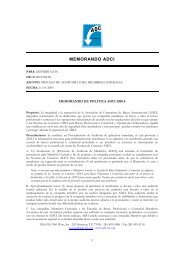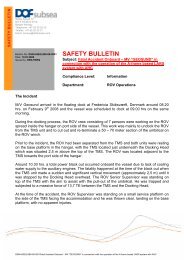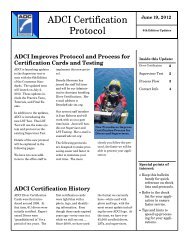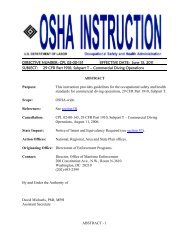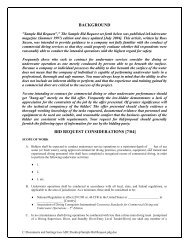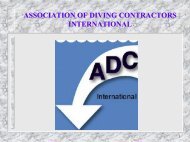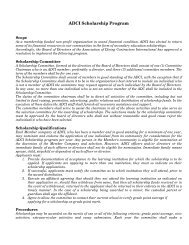ADCI STD10 _On-the-Job_ Supplement 1.pdf - Association of Diving ...
ADCI STD10 _On-the-Job_ Supplement 1.pdf - Association of Diving ...
ADCI STD10 _On-the-Job_ Supplement 1.pdf - Association of Diving ...
Create successful ePaper yourself
Turn your PDF publications into a flip-book with our unique Google optimized e-Paper software.
<strong>Association</strong> <strong>of</strong> <strong>Diving</strong> Contractors<br />
International<br />
<strong>ADCI</strong> STANDARD 10-1999 – SUPPLEMENT 1<br />
<strong>On</strong> The <strong>Job</strong> Training Procedures<br />
Scope: <strong>ADCI</strong> Standard 10-1999 establishes a procedure whereby<br />
commercial diver personnel must complete at least 317 hours<br />
<strong>of</strong> formal training at an accredited commercial or military<br />
diving school. Provisions are made for an additional 308<br />
hours <strong>of</strong> on-<strong>the</strong>-job training to satisfy <strong>the</strong> requirements<br />
necessary for <strong>the</strong> individual to obtain formal <strong>ADCI</strong><br />
commercial diving certification after having completed <strong>the</strong><br />
required field service and number <strong>of</strong> dives.<br />
The <strong>ADCI</strong> Consensus Standards for Commercial <strong>Diving</strong><br />
Operations, Chapter 2., paragraph C.5 sets forth <strong>the</strong><br />
required curriculum for completion <strong>of</strong> 308 hours <strong>of</strong> on-<strong>the</strong>job<br />
training.<br />
The requirements are:<br />
Subject<br />
Hours<br />
Trainee Participation in Chamber Operations 44<br />
Seamanship & Rigging Fundamentals 25<br />
Practical Application <strong>of</strong> Seamanship and Rigging 60<br />
Maintenance <strong>of</strong> Divers Umbilical 12<br />
Underwater Work Using Lightweight <strong>Diving</strong> Equipment 65<br />
Underwater Tools 24<br />
Hot Water Systems 2<br />
Introduction to Topside Welding 26<br />
Topside Welding Equipment 12<br />
Oxygen-Acetylene Cutting Techniques 10<br />
Practical Application <strong>of</strong> Oxygen-Acetylene Cutting 12<br />
Marine Engines and Compressors 16<br />
Procedure: <strong>ADCI</strong> member companies that employ personnel who have<br />
completed less than 625 hours <strong>of</strong> formal academic training<br />
in commercial diving subjects as set forth in ANSI/ACDE-01-<br />
1998 shall ensure that diver personnel receive <strong>the</strong> required<br />
on-<strong>the</strong>-job training necessary to meet requirements <strong>of</strong><br />
referenced <strong>ADCI</strong> Standards.<br />
It is not <strong>the</strong> intent <strong>of</strong> <strong>ADCI</strong> to define in what manner <strong>the</strong><br />
on-<strong>the</strong>-job training is accomplished. It is however, a<br />
responsibility <strong>of</strong> <strong>ADCI</strong> to enumerate <strong>the</strong> general content <strong>of</strong>
each curriculum item as extracted from <strong>the</strong> Commercial Diver<br />
Training – Minimum Standard set forth in ANSI/ACDE-01-1998.<br />
Each company will establish <strong>the</strong> mechanism appropriate to<br />
<strong>the</strong>ir organizational structure and internal requirements to<br />
satisfy and properly record that <strong>the</strong> requisite training has<br />
been accomplished. It is recommended that on-<strong>the</strong>-job<br />
training be recorded in each divers’ personnel records and<br />
also be recorded in <strong>the</strong> Divers Log Book section reserved<br />
for such entries.<br />
Training: Set forth below is <strong>the</strong> Objectives and Outline <strong>of</strong><br />
Instruction for each <strong>of</strong> <strong>the</strong> identified subjects. Where an<br />
individual can demonstrate pr<strong>of</strong>iciency in a subject from<br />
o<strong>the</strong>r forms <strong>of</strong> employment or on-<strong>the</strong>-job training experience<br />
outside <strong>the</strong> accredited commercial or military school<br />
courses <strong>of</strong> instruction, that pr<strong>of</strong>iciency may be considered<br />
as having satisfied <strong>the</strong> training hours <strong>of</strong> that particular<br />
subject.<br />
TRAINEE PARTICIPATION IN CHAMBER OPERATIONS [44]<br />
A. Objectives:<br />
To provide <strong>the</strong> trainee with practice in <strong>the</strong> operational<br />
procedures <strong>of</strong> a Hyperbaric chamber and simulating <strong>the</strong><br />
treatment <strong>of</strong> diving injuries.<br />
To develop trainee skills in <strong>the</strong> proper decompression and<br />
recompression operations.<br />
B. Outline <strong>of</strong> Instruction:<br />
Review operating procedures for <strong>the</strong> chamber<br />
Practice maintaining steady rate <strong>of</strong> ascent/descent<br />
Conduct simulated treatments<br />
Use <strong>of</strong> man lock, treatment lock, and <strong>the</strong> purpose <strong>of</strong> medical<br />
locks<br />
Conduct simulated treatment using oxygen and/or nitrox<br />
Practice maintaining required pressure while ventilating<br />
Safety precautions<br />
Decompression operations<br />
• Surface decompressions using oxygen and/or nitrox<br />
• Surface decompression using air<br />
Lock in/lock out procedures<br />
Pressure test<br />
SEAMANSHIP & RIGGING FUNDAMENTALS [25]<br />
A. Objectives:<br />
To provide <strong>the</strong> trainee with knowledge <strong>of</strong> <strong>the</strong> construction,<br />
use, and care, <strong>of</strong> fiber, syn<strong>the</strong>tic, and wire rope.<br />
To familiarize <strong>the</strong> trainee with <strong>the</strong> purpose, and use <strong>of</strong><br />
splices in fiber and wire rope.
To instruct <strong>the</strong> trainee in <strong>the</strong> purpose and use <strong>of</strong> terminal<br />
fittings on wire rope.<br />
To introduce <strong>the</strong> trainee to <strong>the</strong> applicable sections <strong>of</strong> <strong>the</strong><br />
American Petroleum Institute.<br />
B. Outline <strong>of</strong> Instruction:<br />
Fiber and Wire Rope<br />
a. Types, Sizes (how measured), Care and maintenance<br />
Syn<strong>the</strong>tic rope<br />
a. Nylon, Polyester (Dacron), Polypropolene<br />
Splices<br />
a. Types, application, strength, safety factors<br />
Wire rope clips<br />
a. Use, method <strong>of</strong> application, strength<br />
Terminal fittings<br />
a. Types, strength, method <strong>of</strong> application<br />
Blocks and tackles and mechanical advantage<br />
Come alongs, chain hoists, shackles, and grip hoist<br />
Winches and air tuggers<br />
Hand signals for controlling crane operations<br />
Calculations <strong>of</strong> problems for safe working load and breaking<br />
strain for fiber and wire rope<br />
Slings<br />
Performance <strong>of</strong> underwater projects for practical application<br />
<strong>of</strong> rigging<br />
PRACTICAL APPLICATION OF SEAMANSHIP AND RIGGING [60]<br />
A. Objectives: To provide <strong>the</strong> trainee practice in <strong>the</strong> application<br />
<strong>of</strong> seamanship and rigging<br />
B. Outline <strong>of</strong> Instruction:<br />
Splices – eye, short, long<br />
Splices in wire rope – Flemish, eye (3 strand), back (3<br />
strand), short<br />
Knots and hitches – square knot; hitches (clove, rolling,<br />
timber, telegraph, two half hitches, round turn & two half<br />
hitches, girth); fisherman’s, single sheet, & double sheet<br />
bends; cats-paw; prussic; bowlines (single, running, stopper,<br />
French, double, baker) bowlines, double carrick<br />
Practical application <strong>of</strong> knot tying and splicing<br />
Reeving <strong>of</strong> block and tackles<br />
Hooks<br />
Mechanical advantage<br />
Chain<br />
MAINTENANCE OF DIVERS UMBILICAL [12]<br />
A. Objectives:<br />
To instruct <strong>the</strong> trainee in <strong>the</strong> proper method for making-up,
maintaining, and testing dive hose<br />
To provide practice to <strong>the</strong> trainee in making-up and testing<br />
dive hose<br />
B. Outline <strong>of</strong> Instruction:<br />
Lifelines – make-up, maintenance, minimum strength<br />
requirement, testing, snap shackle types/sizes<br />
Airhose – make-up, maintenance, testing, marking<br />
Air hose connection<br />
Checking for safety<br />
Communications cable: care and maintenance<br />
Practical application<br />
UNDERWATER WORK USING LIGHTWEIGHT DIVING EQUIPMENT [65]<br />
A. Objectives:<br />
To provide <strong>the</strong> trainee with practical experience in diving and<br />
lightweight equipment<br />
To provide <strong>the</strong> trainee experience in some <strong>of</strong> <strong>the</strong> more<br />
difficult underwater tasks encountered in commercial diving<br />
To familiarize <strong>the</strong> trainee with safety issues surrounding<br />
using lightweight diving gear, and hazards encountered (i.e.<br />
liveboating)<br />
B. Outline <strong>of</strong> Instruction:<br />
Safety Precautions<br />
Emergency procedures for loss <strong>of</strong> gas - bail out, pneumo hose,<br />
standby diver procedures<br />
Bottom search project (lost object recovery)<br />
Single flange up<br />
Blank flange removal<br />
Multiple bolts and flange projects<br />
Penetration (outfalls and intakes)<br />
Overhead patches, sea chests<br />
Angle descent line<br />
Hogging line project<br />
Excavating and dredging – air lifts, hand jetting<br />
C. Liveboating:<br />
Operational considerations (sunset rule, visibility, sea<br />
state, vessel, tending considerations)<br />
Safety considerations (depth, standby boat, propeller<br />
shutdown, propeller guards, standby diver, bailout, bottom<br />
time limits)<br />
UNDERWATER TOOLS [24]<br />
A. Objectives:<br />
To provide <strong>the</strong> trainee with a knowledge <strong>of</strong> <strong>the</strong> care and use <strong>of</strong><br />
tools and equipment used underwater
To familiarize <strong>the</strong> trainee with safety precautions required to<br />
safely use tools and equipment underwater<br />
B. Outline <strong>of</strong> Instruction:<br />
Nomenclature and use <strong>of</strong> tools – hand,<br />
pneumatic/hydraulic/special, dredges and air-lifts, lift<br />
bags<br />
Underwater use <strong>of</strong> tools<br />
Inspections/Maintenance <strong>of</strong> tools<br />
Safety precautions<br />
Practical application<br />
HOT WATER SYSTEMS [2]<br />
A. Objectives:<br />
To list <strong>the</strong> terms associated with diver’s hot water systems<br />
and <strong>the</strong> problems associated with <strong>the</strong> effects <strong>of</strong> cold<br />
To provide practical experience in <strong>the</strong> set-up, operation,<br />
shut down, and maintenance <strong>of</strong> divers’ hot water systems<br />
B. Outline <strong>of</strong> Instruction:<br />
System description<br />
Operational procedures<br />
Hot water suits and umbilical<br />
Maintenance and troubleshooting<br />
Safety Procedures<br />
Practical experience in operation and maintenance <strong>of</strong><br />
diver’s hot water system<br />
INTRODUCTION TO TOPSIDE WELDING [26]<br />
A. Objectives:<br />
To provide proper training so <strong>the</strong> student can understand <strong>the</strong><br />
applications <strong>of</strong> topside welding, explain <strong>the</strong> limitations <strong>of</strong><br />
topside welding in regard to size <strong>of</strong> project, position, and<br />
condition <strong>of</strong> metals being welded. Students should be able to<br />
describe <strong>the</strong> techniques for topside welding in <strong>the</strong> flat,<br />
vertical, and overhead positions.<br />
B. Outline <strong>of</strong> Instruction:<br />
Application <strong>of</strong> topside welding<br />
Limitations <strong>of</strong> topside welding<br />
Topside welding techniques<br />
TOPSIDE WELDING EQUIPMENT [12]<br />
A. Objectives:<br />
To assist <strong>the</strong> student to name and describe <strong>the</strong> functions <strong>of</strong><br />
<strong>the</strong> components <strong>of</strong> topside welding equipment and to describe<br />
<strong>the</strong> safety precautions prescribed for topside welding.<br />
B. Outline <strong>of</strong> Instruction:
Welding machines<br />
Welding cables<br />
Electrode holders<br />
Electrodes<br />
Welding glass and faceplate<br />
Safety Precautions<br />
OXYGEN-ACETYLENE CUTTING TECHNIQUES [10]<br />
A. Objectives:<br />
To describe <strong>the</strong> basic techniques <strong>of</strong> oxy-acetylene cutting. At<br />
<strong>the</strong> conclusion, <strong>the</strong> student will be able to name and describe<br />
<strong>the</strong> function <strong>of</strong> each component <strong>of</strong> oxy-acetylene cutting<br />
equipment and <strong>the</strong> necessary safety precautions.<br />
B. Outline <strong>of</strong> Instruction:<br />
History <strong>of</strong> oxy-acetylene cutting<br />
The torch<br />
Oxygen cylinders/care in handling<br />
Gauges for oxygen cylinders/care in handling<br />
Safety precautions in oxy-acetylene cutting<br />
Technique for oxy-acetylene cutting<br />
PRACTICAL APPLICATION OF OXYGEN-ACETYLENE METHOD OF CUTTING [12]<br />
A. Objectives:<br />
To instruct <strong>the</strong> student on techniques for cutting various<br />
thickness <strong>of</strong> plate, pipe & structures employing <strong>the</strong> oxyacetylene<br />
method.<br />
B. Outline <strong>of</strong> Instruction:<br />
Construction and nomenclature <strong>of</strong> cutting equipment<br />
Setting up equipment<br />
Techniques<br />
Accomplish projects<br />
Safety precautions<br />
MARINE ENGINES AND COMPRESSORS [16]<br />
A. Objectives:<br />
To provide <strong>the</strong> trainee with fundamental knowledge <strong>of</strong> <strong>the</strong><br />
operation, maintenance, and field troubleshooting <strong>of</strong> diesel<br />
engines and low pressure compressors.<br />
B. Outline <strong>of</strong> Instruction:<br />
Application <strong>of</strong> diesel engines in diving<br />
Air compressors<br />
Generators<br />
Cranes<br />
Boats<br />
Trucks<br />
Forklifts
Hydraulic Power Plans<br />
Etc.<br />
Systems common to all diesel engines<br />
Fuel System<br />
Fuel Filter<br />
Injectors<br />
Lubrication<br />
Cooling<br />
Intake<br />
Exhaust<br />
Power Take Offs and Clutches<br />
Diesel operation (practical)<br />
Maintenance (practical)<br />
Trouble Shooting (practical)<br />
Types <strong>of</strong> compressors used in diving<br />
Compressor systems<br />
Intake<br />
Compression stage<br />
Intercooler<br />
Lubrication – Oil Selection<br />
Variable Differential Unloader<br />
Hydraulic Unloader<br />
Filters<br />
Volume Tanks<br />
Supply valves/manifold<br />
Compressor calculations<br />
Capacity (CFM/SCFM)<br />
Depth limit (over bottom pressure)<br />
Set up <strong>of</strong> compressors used in diving/chamber systems<br />
Compressor operation (practical)<br />
Compressor maintenance (practical)<br />
Troubleshooting (practical)<br />
Air purity testing<br />
Valves and fittings<br />
Air system schematic<br />
Promulgated August 2000


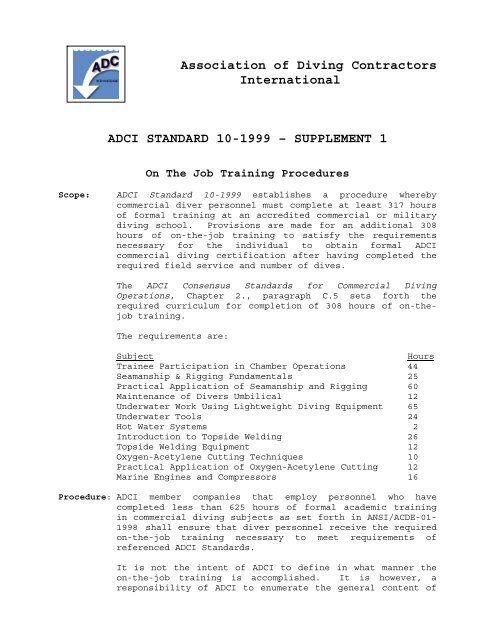
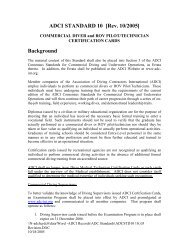
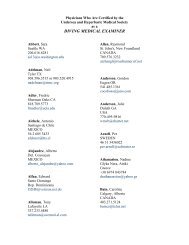
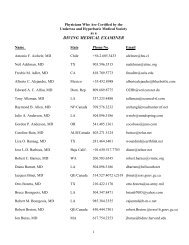
![SOLICITUD MEMBRESIA ASOCIADO [Rev 06/08] - Association of ...](https://img.yumpu.com/48291988/1/190x245/solicitud-membresia-asociado-rev-06-08-association-of-.jpg?quality=85)

